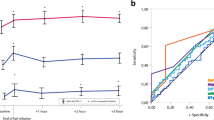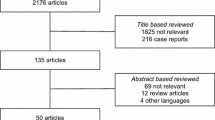Summary
The haemodynamic effects of single oral doses of alifedrine 40 mg, 50 mg, 60 mg and placebo were compared in 30 patients with mild to moderate heart failure. Individual patients received either alifedrine 60 mg and placebo (15 patients) or alifedrine 40 mg and 50 mg (15 patients).
All doses of alifedrine produced qualitatively similar haemodynamic responses, with maximum changes between 90 and 180 min after drug administration. The cardiac index was increased by +39%, +57% and +50% by 40 mg, 50 mg and 60 mg, respectively. The increases were due to rises in stroke volume index (SVI) and in heart rate of +15%, +20% and +23%. Mean arterial blood pressure fell in a dose-related fashion, with a maximum fall of 11% by 120 min after 60 mg. The systemic vascular resistance index (SVRI) fell by 28%, 39% and 41%, and pulmonary vascular resistance index (PVRI) by 32%, 44% and 32% after 40 mg, 50 mg and 60 mg, respectively.
The optimum dose appears to be 40 mg, which caused very little fall in blood pressure or increase in heart rate, yet significantly improved cardiac output. Alifedrine may have a place in the treatment of heart failure as an oral by active, positive inotropic agent.
Similar content being viewed by others
References
Smith TW, Braunwald E (1984) The management of heart failure. In: Braunwald E (ed) Heart disease: A textbook of cardiovascular medicine, 2nd edn. WB Saunders, Philadelphia, vol 4, pp 503–559
Cohn JN, Franciosa JA (1977) Vasodilator therapy of cardiac failure. N Engl J Med 297: 27–31, 254–258
Beller GA, Smith TW, Abelmann WH, Haber E, Hood WB Jr (1971) Digitalis intoxication: A prospective clinical study with serum level correlation. N Engl J Med 284: 989–997
Colucci WS, Wright RF, Braunwald E (1986) New positive inotropic agents in the treatment of congestive heart failure: Mechanism of action and recent clinical developments. N Engl J Med 314: 290–299, 349–358
Bahre M, Engel J, Hoff W, Kutscher B, Sroman F (1986) Alifedrine. In: Scriabine A (ed). New cardiovascular drugs. Raven Press, New York, pp 41–62
Schanzenbacher P, Hockerto T, Riegger G, Liebau K, Kochsiek K (1983) Effect of the new cardiotoxic agent D 13625 in patients with congestive heart failure. Circulation 68: 3–18
Miller RR, Awan NA, Jaye JA, Maxwell KS, De Maria AN, Amsterdam EA, Mason DT (1977) Combined dopamine and nitroproside therapy in congestive heart failure; greater augmentation of cardiac performance by addition of inotropic stimulation to after load reduction. Circulation 55: 881–884
Colucci WS, Alexander RW, Williams GH, Rude RE, Holman BL, Konstam MA, Wynne J, Mudge GH, Braunwald E (1981) Decreased lymphocyte beta-adrenergic-receptor density in patients with heart failure and tolerance to the beta-adrenergic agonist pirbuterol. N Engl J Med 305: 185–190
Bristow MR, Ginsburg R, Minobe W, Cubiccioti RS, Sageman WS, Lurie K, Billingham ME, Harrison DC, Stinson EB (1982) Decreased catecholamine sensitivity and beta-adrenergic-receptor density in failing human hearts. Engl J Med 216: 205–211
Maskin C, Forman R, Klein N, Sonnenblick E, Lejemtel T (1982) Long-term amrinone therapy in patients with severe heart failure. Am J Med 72: 113–118
Baim D, McDowell A, Cherniles J, Monrad E, Parker J, Edelson J, Braunwald E, Grossman W (1983) Evaluation of a new bipyridine inotropic agent milrinone in patients with severe congestive heart failure. N Engl J Med 309: 748–756
Shah PK, Amin DK, Hulse S, Shellock F, Swam HJC (1985) Inotropic therapy for refractory congestive heart failure with oral fenoximone (MDL-17,043): Poor long-term results despite early haemodynamic and clinical improvement. Circulation 71: 326–331
Colucci WS, Wright RF, Jaski BE, Fifer MA, Braunwald E (1986) Milrinone and dobutamine in patients with severe heart failure: differing haemodynamic effects and individual patient responsiveness. Circulation 73 [Suppl 3]
Packer M, Medina N, Yashak M (1984) Haemodynamic and clinical long-term limitation with amrinone in patients with severe chronic heart failure. Circulation 70: 1038–1047
Lejemtel T, Sonnenblick E (1984) Should the failing heart be stimulated? N Engl J Med 310: 1384–1385
Siegel LA, Keung E, Siskind SJ, Forman R, Feinberg H, Strom J, Efstathakis D, Sonnenblick EH, Lejemtel TH (1981) Beneficial effects of amrinone-hydralazine combination on resting haemodynamic and exercise capacity in patients with severe congestive heart failure. Circulation 63: 838–844
Miller R, Palomo A, Brandon T, Hartley C, Quininones M (1981) Combined vasodilator and inotropic therapy of heart failure: Experimental and clinical concepts. Am Heart J 102: 500–508
Author information
Authors and Affiliations
Rights and permissions
About this article
Cite this article
Anand, I.S., Hughes, L.O., Whittington, J.R. et al. Acute haemodynamic effects of different doses of alifedrine in congestive heart failure. Eur J Clin Pharmacol 36, 335–341 (1989). https://doi.org/10.1007/BF00558291
Received:
Accepted:
Issue Date:
DOI: https://doi.org/10.1007/BF00558291




